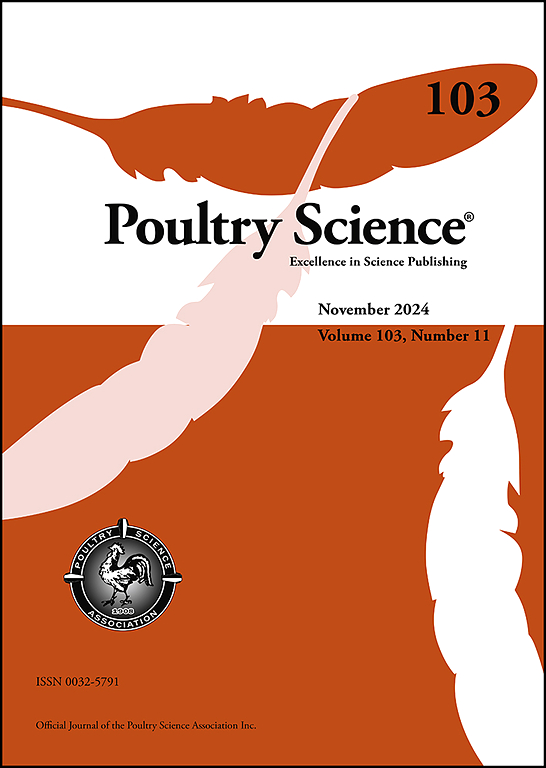Integrated transcriptomic and metabolomic analysis reveals key regulatory genes and pathways associated with feed conversion efficiency in Tianchang Sanhuang chicken
IF 4.2
1区 农林科学
Q1 AGRICULTURE, DAIRY & ANIMAL SCIENCE
引用次数: 0
Abstract
Improving feed efficiency in Tianchang Sanhuang chickens is essential for reducing production costs and environmental burden. The objective of this study was to integrate transcriptomic and metabolomic analyses to identify key regulatory genes, metabolites, and pathways associated with residual feed intake (RFI) and feed efficiency. In this study, 650 Tianchang Sanhuang laying hens with similar body weights at 36 weeks of age were evaluated for daily feed intake (DFI), RFI, and feed conversion ratio (FCR). The chickens were classified by RFI (mean ± 0.5 SD) into high-RFI (HRFI, n = 165) and low-RFI (LRFI, n = 158) groups. Phenotypes, serum biochemistry, antioxidant indices, and intestinal traits were compared in subsets (n = 8 per group). Duodenal transcriptomes (RNA-seq) and serum metabolomes (LC-MS/MS) were profiled in independent subsets (n = 4 per group). Compared with HRFI, LRFI hens showed lower RFI, FCR, and DFI (P < 0.01), with no differences in expected feed intake (EFI), metabolic body weight (MBW), daily egg mass (DEM), or average daily gain (ADG) (P > 0.05). The LRFI group showed increased breast muscle redness (a)* (P < 0.05), higher leg muscle drip loss (P < 0.01), and significantly lower levels of triglycerides (TG), cholesterol (CHO), low-density lipoprotein cholesterol (LDL-C), and malondialdehyde (MDA) (P < 0.05). The intestinal morphology and molecular analyses revealed enhanced nutrient absorption and intestinal barrier function in the LRFI group. Transcriptomic analysis identified 237 differentially expressed genes (P < 0.05, |log2FC| ≥ 1) enriched in pathways related to digestion, energy metabolism, and appetite regulation. Metabolomic analysis detected 101 differentially expressed metabolites (VIP ≥ 1, |log2FC| ≥ 1), indicating that RFI is closely associated with protein and lipid metabolism. Integrated analysis identified candidate biomarkers for low RFI individuals selection, including genes such as ACSM5, AHSG, CTRB1, PLA2G1B, AMY2A, CPA1, CCKAR and metabolites including taurine, uridine, L-phenylalanine, D-glucose 6-phosphate and 5‑hydroxy-L-tryptophan. Overall, LRFI hens maintain production while achieving lower intake, potentially via reduced inflammation/oxidative stress and enhanced digestion, barrier integrity, appetite, and energy metabolism, offering targets for marker-assisted improvement of feed efficiency in local breeds.
综合转录组学和代谢组学分析揭示了天长三黄鸡饲料转化效率相关的关键调控基因和途径。
提高天长三黄鸡的饲料效率对降低生产成本和环境负担至关重要。本研究的目的是整合转录组学和代谢组学分析,以确定与剩余采食量(RFI)和饲料效率相关的关键调控基因、代谢物和途径。本试验选用650只体重相近的36周龄天长三黄蛋鸡,测定日采食量、RFI和饲料系数。按RFI(平均±0.5 SD)分为高RFI组(HRFI, n = 165)和低RFI组(LRFI, n = 158)。各组比较表型、血清生化、抗氧化指标和肠道性状(每组n = 8)。十二指肠转录组(RNA-seq)和血清代谢组(LC-MS/MS)在独立的亚组中进行分析(每组n = 4)。与HRFI相比,LRFI鸡的RFI、FCR和DFI显著降低(P < 0.01),但预期采食量(EFI)、代谢体重(MBW)、日产蛋量(DEM)和平均日增重(ADG)无显著差异(P < 0.05)。LRFI组胸肌红度增加(a)* (P < 0.05),腿部肌滴损失增加(P < 0.01),甘油三酯(TG)、胆固醇(CHO)、低密度脂蛋白胆固醇(LDL-C)和丙二醛(MDA)水平显著降低(P < 0.05)。肠道形态学和分子分析显示,LRFI组的营养吸收和肠道屏障功能增强。转录组学分析发现237个差异表达基因(P < 0.05, |log2FC|≥1)富集于消化、能量代谢和食欲调节相关通路。代谢组学分析检测到101个差异表达代谢物(VIP≥1,|log2FC|≥1),表明RFI与蛋白和脂质代谢密切相关。综合分析确定了低RFI个体选择的候选生物标志物,包括ACSM5、AHSG、CTRB1、PLA2G1B、AMY2A、CPA1、CCKAR等基因和代谢产物,包括牛磺酸、尿苷、l -苯丙氨酸、d -葡萄糖6-磷酸和5 -羟基- l -色氨酸。总体而言,LRFI母鸡在保持产量的同时实现了较低的采食量,这可能是通过减少炎症/氧化应激、增强消化、屏障完整性、食欲和能量代谢来实现的,为标记辅助提高当地品种的饲料效率提供了目标。
本文章由计算机程序翻译,如有差异,请以英文原文为准。
求助全文
约1分钟内获得全文
求助全文
来源期刊

Poultry Science
农林科学-奶制品与动物科学
CiteScore
7.60
自引率
15.90%
发文量
0
审稿时长
94 days
期刊介绍:
First self-published in 1921, Poultry Science is an internationally renowned monthly journal, known as the authoritative source for a broad range of poultry information and high-caliber research. The journal plays a pivotal role in the dissemination of preeminent poultry-related knowledge across all disciplines. As of January 2020, Poultry Science will become an Open Access journal with no subscription charges, meaning authors who publish here can make their research immediately, permanently, and freely accessible worldwide while retaining copyright to their work. Papers submitted for publication after October 1, 2019 will be published as Open Access papers.
An international journal, Poultry Science publishes original papers, research notes, symposium papers, and reviews of basic science as applied to poultry. This authoritative source of poultry information is consistently ranked by ISI Impact Factor as one of the top 10 agriculture, dairy and animal science journals to deliver high-caliber research. Currently it is the highest-ranked (by Impact Factor and Eigenfactor) journal dedicated to publishing poultry research. Subject areas include breeding, genetics, education, production, management, environment, health, behavior, welfare, immunology, molecular biology, metabolism, nutrition, physiology, reproduction, processing, and products.
 求助内容:
求助内容: 应助结果提醒方式:
应助结果提醒方式:


